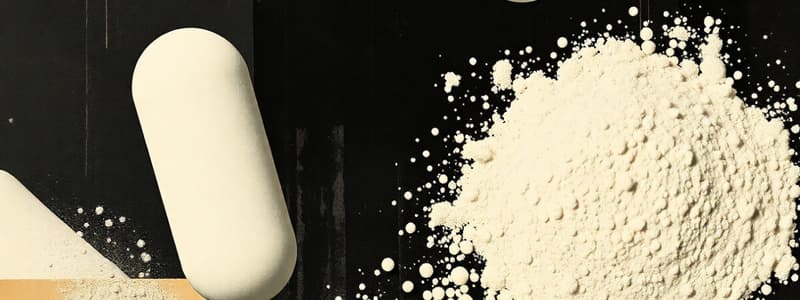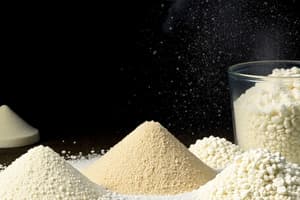Podcast
Questions and Answers
A pharmaceutical powder is solely used for external administration.
A pharmaceutical powder is solely used for external administration.
False (B)
Granules are aggregates of powder particles that may contain one or more active pharmaceutical ingredients.
Granules are aggregates of powder particles that may contain one or more active pharmaceutical ingredients.
True (A)
The usual size range of granules is 1–2 # sieve.
The usual size range of granules is 1–2 # sieve.
False (B)
Characterization of powders includes assessing their morphology and stability.
Characterization of powders includes assessing their morphology and stability.
The mesh size of a sieve refers to the size of the openings per linear foot.
The mesh size of a sieve refers to the size of the openings per linear foot.
Uniform particle sizes in powders can lead to easier blending.
Uniform particle sizes in powders can lead to easier blending.
The USP classification includes terms that describe the coarseness of particles, such as very coarse and fine.
The USP classification includes terms that describe the coarseness of particles, such as very coarse and fine.
A powdered substance can only be used in the preparation of solid dosage forms.
A powdered substance can only be used in the preparation of solid dosage forms.
Dusting powders are typically dispensed in containers with a solid lid for easy application.
Dusting powders are typically dispensed in containers with a solid lid for easy application.
Topical powders can include both active pharmaceutical ingredients and excipients.
Topical powders can include both active pharmaceutical ingredients and excipients.
Sterile powders for cutaneous application can be formulated without concerns for sterility.
Sterile powders for cutaneous application can be formulated without concerns for sterility.
Purified talc or maize starch are used to ensure good flow properties in dusting powders.
Purified talc or maize starch are used to ensure good flow properties in dusting powders.
Bulk powders always have a low bulk density, making them difficult to measure.
Bulk powders always have a low bulk density, making them difficult to measure.
A sieve size of 50-100 is classified as very fine.
A sieve size of 50-100 is classified as very fine.
Particles sized between 1-5 µm are ideal for inhalation to reach the deep respiratory tract.
Particles sized between 1-5 µm are ideal for inhalation to reach the deep respiratory tract.
Oral powders can only be administered with water and cannot be swallowed directly.
Oral powders can only be administered with water and cannot be swallowed directly.
Nasal powders are designed for medicinal effects when inhaled through the nasal cavity.
Nasal powders are designed for medicinal effects when inhaled through the nasal cavity.
Fine powders for dermal applications should ideally be larger in size, around 100-200 µm.
Fine powders for dermal applications should ideally be larger in size, around 100-200 µm.
Inhalation powders require an inhalation device for effective administration.
Inhalation powders require an inhalation device for effective administration.
The lack of grittiness in solid particles is desirable in oral powders but not in topical applications.
The lack of grittiness in solid particles is desirable in oral powders but not in topical applications.
Granules used for tableting should be very coarse in size.
Granules used for tableting should be very coarse in size.
Flashcards are hidden until you start studying
Study Notes
Powder Dosage Forms
- A powdered medication is a combination of finely divided medicinal substances, intended for internal or external use.
- Powders are a long-standing dosage form, employed both internally and externally.
Granules
- Granules consist of dry aggregates of powder particles, possibly containing active pharmaceutical ingredients (APIs), with or without additional ingredients.
- Granules can be used directly for medicinal value or in the preparation of other dosage forms, such as tablets.
- The typical size range of granules is between 4–12 mesh sieve.
Uses of Powders
- Therapeutic effects (limited).
- Extensive application in the manufacture of other dosage forms:
- Solid dosage forms (tablets and capsules).
- Liquid dosage forms (dissolving or suspending in solvents).
- Semisolid preparations (medicated ointments and creams).
Characterization of Powders
- Requires identification of key characteristics, including:
- Morphology.
- Purity.
- Solubility.
- Flowability.
- Stability.
- Particle size.
- Uniformity.
- Compatibility with other formulation components
Particle Size
- Generally, uniform particle sizes facilitate easier blending.
- The United States Pharmacopeia (USP) categorizes particle size as: very coarse, coarse, moderately coarse, fine, and very fine.
- Sieves can be identified by aperture size (opening) or mesh size (sieve number).
- Mechanical sieve shakers are used to measure particle size.
Opening of Standard Sieves
- Particle Size | Description
- 120-400 | Very Fine
- 50-100 | Fine
- 30-40 | Moderately Coarse
- 10-20 | Coarse
- 2-8 | Very Coarse
- 4-12 | Granules
- 120-20 | Tableting
Influence of Particle Size
- Dissolution rate: Micronization can increase dissolution rate and bioavailability.
- Suspendability: Ensures uniform dispersion of undissolved particles in liquids (e.g., fine dispersions 0.5 to 10 µm).
- Distribution uniformity: Ensures consistent drug content within powder mixtures or solid dosage forms.
- Penetrability: Important for inhaled medication, allowing deposition deep within the respiratory tract (e.g., 1-5 µm).
- Grittiness: Fine particles (e.g., 50-100 µm) are required to avoid a gritty texture in dermal ointments, creams, and ophthalmic preparations.
Classification of Powders & Granules by Route of Administration
- Oral powders
- Inhalation powders
- Nasal powders
- Topical powders
- Dusting powders
Oral Powders
- Formulated with dry, loose particles of varying fineness.
- Contain one or more active ingredients, with or without excipients, coloring agents, and flavoring.
- Typically administered with water or other liquids, but can be swallowed directly.
Inhalation Powders
- Effective for delivering active ingredients to the lungs, treating asthma and chronic obstructive pulmonary disease (COPD).
- Require an inhalation device for administration, producing a fine cloud of particles.
- Drug can be preloaded or filled into capsules/blister packs for loading into the inhalation device.
Nasal Powders
- Designed for inhalation into the nasal cavity using a suitable device.
- Rapid absorption of potent drugs administered as fine nasal powders.
- Often combined with an inert excipient (e.g., lactose) to release the drug upon administration.
Topical Powders
- Applied to the skin.
- Contain active ingredients, excipients, coloring agents.
- Sterile powders require materials and methods that ensure sterility and prevent contamination.
Dusting Powders
- For cutaneous application, with suitable fineness..
- Dispensed in containers with perforated lids, requiring good flow properties for dusting.
- Active ingredients are often diluted with substances with favorable flow characteristics (e.g., purified talc or maize starch).
- Examples: Canesten Powder (clotrimazole) for antifungal treatment; Talc Dusting Powder for lubrication.
Bulk Powders
- Example: Antacids, where patients self-administer by mixing with water.
Powder Excipients
- Essential properties for powder excipients:
- Narrow particle size distribution.
- Favorable flowability.
- Good pressure-hardness profile (for tablet formulations).
- High capacity.
- High bulk density (measured by the volume of a specific weight).
Studying That Suits You
Use AI to generate personalized quizzes and flashcards to suit your learning preferences.




